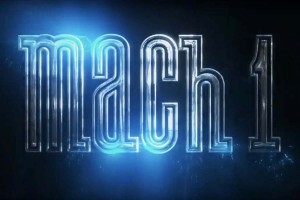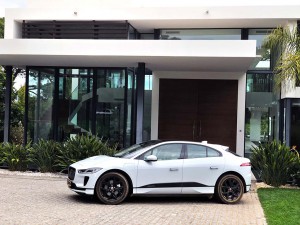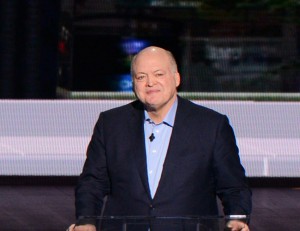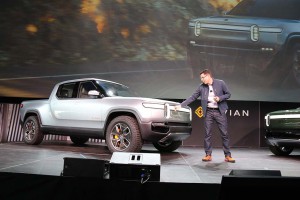
Ford is counting on its "Mustang-inspired," long-range electric SUV, codenamed Mach1, to help it plug into the emerging BEV market.
Ford Motor Co. will launch its “Mustang-inspired,” crossover later this year, its first long-range battery-electric vehicle, and CEO Jim Hackett told shareholders that while the EV market has been slow to build momentum, “When it happens you want to be there.”
Hackett focused a lot of his energy on describing the automaker’s electrification plans during Ford’s first “virtual” shareholders meeting on Thursday, clearly hoping to build support for a program in which it plans to invest $11 billion by 2022, more than double what Hackett’s predecessor, Mark Fields, had committed to spend by 2020. All told, Ford has laid out plans to roll out 40 hybrids, plug-ins and pure battery-electric vehicles, or BEVs.
The question is whether there will be a market for those vehicles, especially when considering the generally tepid response for earlier Ford battery-based models like the C-Max Energi, a PHEV, and the Ford Focus Electric, a BEV.“When there’s new technologies, it takes a while, and there’s a tipping point,” Hackett said, adding that, “When it happens, you want to be there.”
(Barely one in six Americans ready to consider an all-electric vehicle. Click Here for more on the AAA study.)
The former Steelcase chief executive – who took over as Ford CEO following a May 2015 management shake-up – said the signs are turning in the right direction, with the company’s internal research indicating one in five “younger” American motorists “would consider buying an EV in the future.” Precisely what that translates into, especially in the near-term, Hackett didn’t say. But a AAA study released on Thursday found that 16% of the American motorists it surveyed are giving serious consideration to an electric car for their next vehicle.
Ford delivered a surprise to the automotive community when it announced the electric crossover project, codenamed “Mach One,” at the North American International Auto Show in January 2018. But analysts pointed out that performance vehicles like the Mustang coupe typically command a premium over mainstream products. Significantly, a number of competitors have been focusing on sports cars and other high-performance models to mark their entry into the BEV space. One of the first offerings from the Volkswagen Group is the Porsche Taycan sports car.
For its part, the German automaker launched sales of the ID.3. this week, its first long-range mainstream entry. It will be the first model in the new Volkswagen ID sub-brand. VW is committing about $10 billion through 2023 on electrification, with nearly 50 all-electric models planned for its various brands by mid-decade. CEO Herbert Diess recently upped the company’s sales forecast from 15 million to 22 million battery vehicles by 2029. On Thursday, it announced that within 24 hours it had taken over 10,000 advance orders for the ID.3 – which won’t reach showrooms until next year.
Virtually every automaker now has some form of electrification program underway. Daimler, for example, launched sales of its first all-electric model this week, as well, the EQC also the first of a new, battery sub-brand.
(For more about Mercedes’ sales launch of the EQC, Click Here.)
Last year, Mary Barra, the CEO of Ford’s arch-rival General Motors, announced the company is on a “path to an all-electric future.” GM is downplaying hybrids and plug-ins to focus on all-electric models like the Chevrolet Bolt EV, however.
Just last month, Ford announced it was going to invest $500 million in an EV start-up, Rivian – stealing an opportunity from GM which had previously tried but failed to reach a deal of its own with the suburban Detroit start-up.
Rivian revealed a pair of all-electric models, the R1T pickup and R1S sport-utility vehicle, at the Los Angeles International Auto Show last November and hopes to launch production within the next year. It has raised more than $1.2 billion in capital recently, money it needed to help complete both product development and the set-up of its plant in Normal, Illinois.
When word of the deal began leaking out, there were expectations the new company would help Ford electrify its own one-ton pickup, the F-150. In a conference call last month, Hackett said Ford was actually developing its own battery-electric truck and would work with Rivian on at least one other vehicle. He also noted that the $500 million investment was on top of the $11 billion Ford had already committed to electrification.

The Jaguar I-Pace, recently named World Car of the Year, was the first model to "reconceptualize" its design to offer more space for passengers by moving batteries and motors under the load floor.
(Dyson reveals patents and hints at plans to launch electric-car brand in 2021. Click Here for the story.)
While there are still a number of drawbacks to electrification — as the new AAA study highlighted – there are also some significant advantages, including the ability to deliver massive amounts of wheel-spinning torque all but instantaneously. The survey highlighted that consumers interested in the technology also are drawn to their lack of emissions and lower energy costs.
But during the shareholder teleconference, Hackett also pointed to a plus that comes with the latest in BEV design. Most automakers have migrated to skateboard like platforms that mount motors and batteries below the load floor. In turn, much of the traditional engine compartment can be recaptured for use by passengers and consumers.
“What we’ve done is reconceptualized (vehicle design) with all of the extra space that you actually retrieve using battery-electrics,” said Hackett, hinting that this will be apparent once the Mach One project is revealed later this year.


